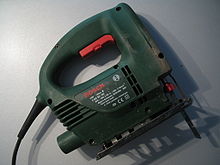



A jigsaw is a reciprocating saw that can cut irregular curves, such as stenciled designs, in wood, metal, or other materials.
Jigsaws first emerged in the 19th century[1] and employed a treadle to operate the blade, which was thin and under tension, being secured at both ends to an oscillating frame. This kind of saw is now usually called a scroll saw.
The modern portable jigsaw, with a rigid blade secured at one end and cutting on the up-stroke, was introduced in 1947 by Scintilla AG (later acquired by Bosch).[2]
A jigsaw power tool is made up of an electric motor and a reciprocating saw blade. Jigsaws with sole plates that have a beveling function can cut angles typically up to 45 degrees relative to the normal vertical stroke to make miter joints. Portable jigsaws have historically been mains-powered, but are increasingly being displaced by battery-powered models.
The tool's ability to carve out irregular shapes lends its name to the jigsaw puzzle, whereby each tile is shaped to connect to its neighbors.